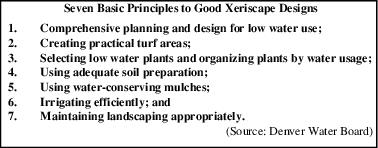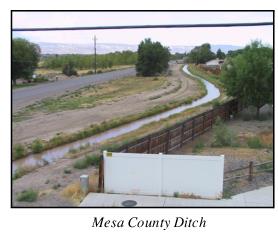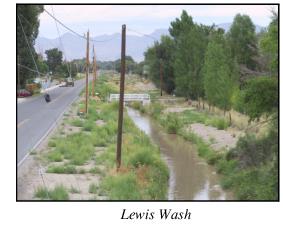Chapter 37.28
GENERAL SERVICES
Sections:
37.28.030 Irrigation/drainage.
37.28.040 Stormwater management.
37.28.060 Solid waste collection/trash pick-up.
37.28.010 General services.
The essential services of sewer, waste collection, potable water and irrigation water are critical components of the health, welfare, and safety of the Pear Park neighborhood.
(Res. 13-05, 1-5-05)
37.28.020 Domestic water.
Clifton Water District and Ute Water Conservancy District provide domestic water service to residents of the planning area. Typically, customer demand is from 100 to 120 gallons per day per person. There are also several residences using wells for domestic water supply. Clifton Water provides service to residents of the area living east of 30 Road. The water supply comes entirely from the Colorado River and the treatment facility is located just east of the Pear Park area. The water delivery system is principally gravity fed with an occasional pump or booster station.
Ute Water serves the area west of 30 Road. The water supply comes from snowmelt on the Grand Mesa which is stored and diverted through a series of reservoirs, ditches and pipes. The treatment facility is located on Rapid Creek. The water delivery system is principally gravity fed. Water delivery within the Pear Park area is predominately made through an 18-inch water line which is fed by a 24-inch main located to the south of Pear Park.
Issues facing both Clifton Water and Ute Water are line sizes. The current policy of both districts is to upgrade as development occurs with the upgrades primarily paid for by the developer. Both water providers have adequate capacity to serve the planning area as it develops to its build-out potential.
 Because of the Grand Junction area’s desert environment, xeriscaping and the use of xeric (low water use) plants works very well. The table to the right lists seven things that can be done to obtain good xeric design.
Because of the Grand Junction area’s desert environment, xeriscaping and the use of xeric (low water use) plants works very well. The table to the right lists seven things that can be done to obtain good xeric design.
(Res. 13-05, 1-5-05)
37.28.030 Irrigation/drainage.
Historically, irrigation delivery systems were designed for farming. Today, those systems are largely incompatible with residential subdivision development, creating problems for end user delivery and tail water drainage. Irrigation water is supplied to many residents living in the Pear Park neighborhood through a series of ditches, laterals and drains that are part of the Grand Valley Irrigation Company system. Water is diverted from the Colorado River at Palisade. The irrigation company’s mainline delivery lateral for Pear Park runs along E Road. A small (northeast corner) part of Pear Park is served by the Palisade Irrigation District on the north side of the Grand Valley Canal.

Grand Valley Irrigation Company is a private non-profit supplier of irrigation water; however, the responsibility for the operation and maintenance of all lateral ditches or pipelines belongs to the individual water user. This also applies to the ditches and pipelines that carry water away from each property until that “waste irrigation water,” or tail water, is returned to the Colorado River or a natural drainageway such as Lewis Wash. Often subdivision homeowner associations (HOAs) are responsible for maintenance of laterals. The irrigation managers prefer that irrigation systems serving new subdivisions be piped resulting in a more efficient and manageable delivery system.
Grand Junction Drainage District operates multiple drainage facilities designed for the purpose of collecting subsurface waters. Historically, when tail water reaches an existing drainage facility, that facility has the capacity to carry additional waters which can be accepted into the system the Grand Junction Drainage District operates and maintains.
(Res. 13-05, 1-5-05)
37.28.040 Stormwater management.
Stormwater management in the Pear Park neighborhood is the responsibility of Mesa County, City of Grand Junction and the Grand Junction Drainage District. The planning area is located in the Indian Wash and Lewis Wash drainage basins. Generally, stormwater flows do not follow jurisdictional boundaries and thus multi-jurisdictional solutions are needed.
In June of 2004, Mesa County, Grand Junction, Fruita, Palisade and Grand Junction Drainage District formed the “5-2-1 Drainage Authority” to provide multi-jurisdictional drainage facilities for stormwater and to manage stormwater quality as mandated under the Clean Water Act and the Colorado Department of Public Health and Environment/Water Quality Control District (Regulation No. 61). Pear Park is a good example for the need of the Authority. Three different agencies are charged with responsibility for stormwater, which can lead to confusion for the residents on who to call when they have a drainage problem.
Mapping of the drainage facilities in Pear Park is underway by the City of Grand Junction, Mesa County and the Grand Junction Drainage District. Mesa County has also compiled drainage information from the various private development studies completed to date.

Stormwater management facilities generally include a means of conveying stormwater runoff from individual lots and streets downstream to an acceptable point of discharge. In some cases, runoff is routed through a detention pond to slow the rate of discharge before being released into downstream facilities. Eventually all runoff ends up in a lake or the Colorado River. The least intrusive method to deal with water quality and stormwater management is to adopt and use best management practices (BMPs) that avoid, minimize and mitigate water runoff activities. The issue of stormwater management is also related to floodplain management (see Chapter 37.36 GJMC, Environmental Resources/River Corridor).
In urban areas, the high percentage of impervious surfaces greatly increases the amount of stormwater runoff from individual lots. Urban stormwater management services require highly technical information and analysis to be effective. As with other urban-level services, municipal governments are better able to provide the more technical level of service required for effective stormwater management in urban areas; however, simple efforts like street sweeping, catch basins, cleanouts and cleaning of underground pipes can improve the quality of runoff without a lot of capital investment.
Stormwater management facilities are also an essential part of new development. New development is required to provide adequate facilities for stormwater runoff. Maintenance of those facilities is the responsibility of the property owners.
(Res. 13-05, 1-5-05)
37.28.050 Sanitary sewer.
The Central Grand Valley Sanitation District and Clifton Sanitation District II provide sewer service to residents of the Pear Park neighborhood. Central Grand Valley collects wastewater and transports it to the Persigo Wastewater Treatment Facility.
The City of Grand Junction and Mesa County jointly own and operate the Persigo Wastewater Treatment Facility. Clifton Sanitation District II collects and currently treats wastewater in a lagoon system in Clifton. The Clifton Sanitation District II plans to build a new treatment facility in the near future. The operation and treatment of sewage treatment facilities are regulated by State statutes and regulations administered by the Colorado Department of Public Health and Environment’s Water Quality Control Division. Sewer line sizes are upgraded as development occurs, with improvements paid for by the developer.
Only a small number of the existing homes in the planning area are not currently being served by sanitary sewer. These homes are served by on-site individual sewage disposal systems, regulated by Mesa County Department of Environmental Health. Failing systems are required to connect to the public sewer system.
(Res. 13-05, 1-5-05)
37.28.060 Solid waste collection/trash pick-up.
City ordinance requires residences within the City of Grand Junction to have their trash picked up by either the City or a private hauler. Residents living within unincorporated Mesa County are not required to have their trash picked up, however many do. Others choose to haul their own garbage to the Mesa County Landfill. There are several private haulers that provide solid waste collection to the Pear Park Neighborhood.
With multiple refuse haulers, there are issues with noise, aesthetics and the number of large trucks driving on neighborhood streets. Consolidating services for individual neighborhoods would reduce:
(a) The frequency of refuse trucks;
(b) The number of days refuse containers are placed at the curb; and
(c) The number of large trucks using the neighborhood streets.
(Res. 13-05, 1-5-05)
37.28.070 Summary.
The background information in this chapter depicts the current conditions in the Pear Park planning area. Throughout the course of researching and writing this chapter, staff did not uncover any new service issues specific to the Pear Park planning area. As a result, the goals and implementation section of this chapter was omitted; however, the goals, policies and implementation items of the City’s Growth Plan and the County’s Joint Urban Planning Area chapter of the Mesa Countywide Land Use Plan continue to apply. City and County staff will continue to implement and refine policies and codes that address the following:
(a) Water conservation, xeriscape and low water use landscaping in new and existing residential subdivisions.
(b) Work with developers of new subdivisions to plan for and use irrigation water in closed/piped delivery systems for its most efficient use.
(c) Work with developers of new subdivisions to incorporate their ditches and delivery systems in accordance with State statutes.
(d) Coordinate public works projects with service providers to eliminate or avoid duplication or redundancy in construction efforts.
(Res. 13-05, 1-5-05)


